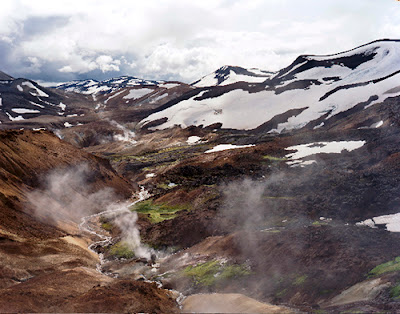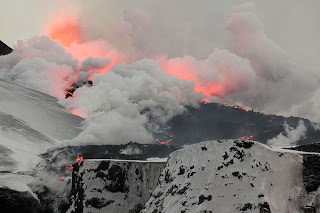One of the most fascinating sights in South Iceland is the aurora borealis, also known as the Northern Lights. It's counterpart in the southern hemisphere is the aurora australis, aptly called the Southern Lights. For centuries mankind has been fascinated with these brilliant, natural light shows in the earth's upper atmosphere. Named after the Roman goddess of dawn, Aurora, and the Greek name for the northern wind, Boreas, the aurora borealis can best be seen in South Iceland between November and March when periods of darkness last around 20-21 hours a day.
The aurora borealis occurs in the ionosphere, an extension of the thermosphere, beginning around 50 km and stretching to more than 1000 km. The ionosphere is distinct because it is ionized by solar radiation from the sun and is comprised of electrically charged atoms and molecules.
 |
Image of the aurora borealis on a cool, clear night in Reykjavik.
|
Carried by solar winds traveling around 1 million miles per hour, highly charged particles, including electrons, escaping the sun interact with the earth's magnetic field along with elements in the atmosphere. Earth's magnetic field traps some of these particles and while spiraling back and forth along the magnetic field lines, they travel lower into the atmosphere near the north and south magnetic poles where the magnetic field lines disappear into the body of the Earth.
The delicate colors are caused when energetic electrons collide with oxygen and nitrogen atoms. This excites the electrically charged atoms, and when they decay from these states, they emit the light seen in the auroras. The colors we see depend on the altitude at which they decay as well as which atom is struck.
Colors of the Auroras
•Green - oxygen, up to 150 miles in altitude
•Red - oxygen, above 150 miles in altitude
•Blue - nitrogen, up to 60 miles in altitude
•Purple/violet - nitrogen, above 60 miles in altitude
| This green aurora borealis is known as a streaming aurora and occurs when a sudden increase in brightness passes horizontally through the sky http://www.chilloutpoint.com/featured/stunning-images-and-legends-of-the-northern-lights-aurora-borealis.html |
 |
| Large, featureless auroras covering the entire sky are known as veils like this rare red aurora borealis. http://www.art.com/products/p13681766-sa-i2708936/michael-s-quinton-red-aurora-borealis-alaska.htm |
 |
Thin beams of bright light that hang almost vertically are called
ray auroras like the ones seen in this picture.
|
 |
Sometimes auroras appear to be patches in the sky like this purple/violet aurora and may also flash, or pulse. |
Closer to earth, oxygen atoms flash a greenish white as oxygen tends to be more "excitable" than other atoms, making this the color most seen in South Iceland. Many people travel to South Iceland to catch a glimpse of this amazing lightshow as clear skies make for a perfect setting. However, not many guided tours are led far from villages due to winter weather and lack of daylight hours.
In South Iceland where so many months are spent in seemingly never ending darkness, the aurora borealis provides those who live there an amazing, natural phenomena directly outside their front doors.
Sources















